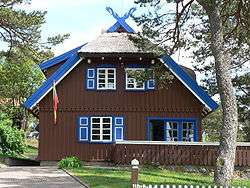Divine twins


The Divine twins are a mytheme of Proto-Indo-European mythology. Examples include the:
- Greek Dioscuri
- Vedic/Hindu Ashvins
- Hindu Nara-Narayana
- Lithuanian Ašvieniai
- Latvian Dieva dēli
- Sicilian Palici
- Germanic deities Alcis
- Italian Romulus and Remus
- Anglo-Saxon Hengest and Horsa
The Yoruba orishas Ibeji are a similar example outside the Indo-European realm.
O'Brien (1982) reconstructs a horse goddess with twin offspring, pointing to Gaulish Epona, Irish Macha (the twins reflected in Macha's pair, Liath Macha and Dub Sainglend), Welsh Rhiannon, and Eddaic Freyja in the tale of the construction of the walls of Asgard, seeing a vestige of the birth of hippomorphic twins in Loki in the form of a mare (in place of Freyja) giving birth to eight-legged Sleipnir. The myths surrounding Hengest and Horsa could come from a common source, since they were descendants of Woden and Hengest's name meant "stallion" (in German: Hengst) Shapiro (1982) points to Slavic Volos and Veles, and collects the following comparative properties:
- sons of the Sky God
- brothers of the Sun Maiden
- association with horses
- dual paternity
- saviours at sea
- astral nature
- magic healers
- warriors and providers of divine aid in battle
- divinities of fertility
- association with swans
- divinities of dance
- closeness to human beings
- protectors of the oath
- assisting at birth
- founders of cities
Similar themes
One recurring element in the divine twin theme is that, while identical, one is divine and the other is human. This points to other characters which partially reflect the mytheme, such as:
- Krishna and Arjuna, as Nara-Narayana - a dual incarnation of Vishnu, while not twins but cousins, many of the elements are present
- Achilles and Patroclus - not twins
- First Man and Son of Man, in the Naassene gnosticism.
- The Thracian Horseman
- Purusha, the cosmic man - very similar to the gnostic First Man, is a primeval giant that is sacrificed by the gods and from whose body the world is built. He is described as having a thousand heads and a thousand feet. He emanated Viraj, the female creative principle, from which he is reborn in turn after the world was made out of his parts. Purusha was dismembered by the devas—his mind is the Moon, his eyes are the Sun, and his breath is the wind. This reminds of the dismemberment mythos, for example that of Like Viraj-Shakti to Purusha, so does Isis recompose the body of Osiris in order to have his offspring, Horus, who then is Osiris' twin.
Literature
- Steven O'Brien, Dioscuric Elements in Celtic and Germanic Mythology, JIES 10 (1982), 117-136.
- Michael Shapiro, Neglected Evidence of Dioscurism (Divine Twinning) in the Old Slavic Pantheon, JIES 10 (1982), 137-166.
- Donald Ward, The Divine Twins: An Indo-European Myth in Germanic Tradition